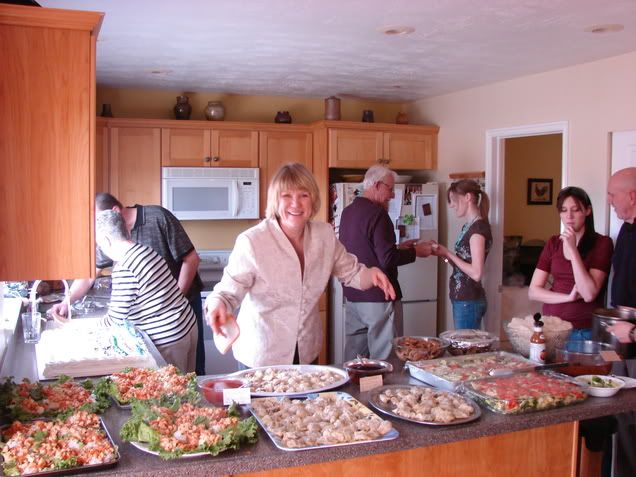my husband and myself were just talking about this man last week! i even went and WIKId his name to see if there was a death date yet for him, because we wanted to know how old this fitness guru was IF he was still alive, and now..hes gone.
He was never anyone in MY generation. No, that honor is held by: RICHARD SIMMONS, lol
but i couldt go through life with my mother and NOT know who Jacl LaLanne was, she knew who he was and what he stood for.
HE may have been one of the very 1st "in your face" Fitness people on a nationwide program, encouraging better health, and low weight.
id say he was the grandfather of all the fitness shows we see, and exercise equipment were told to buy.
a dream of a better and healthier world, started with Jack.
hell be greatly missed.
MICHELLE
Jack LaLanne dies at 96; brought fitness to masses
By ANDREW DALTON
LOS ANGELES (AP)—Jack LaLanne was prodding Americans to get off their couches and into the gym decades before it was cool. And he was still pumping iron and pushing fruits and vegetables decades past most Americans’ retirement age.
The fitness fanatic ate well and exercised—and made it his mission to make sure everyone did the same—right up to the end at age 96, friends and family said.
LaLanne died Sunday at his home in Morro Bay on California’s central coast, longtime agent Rick Hersh said. The cause was respiratory failure due to pneumonia.
“I have not only lost my husband and a great American icon, but the best friend and most loving partner anyone could ever hope for,” Elaine LaLanne, LaLanne’s wife of 51 years and a frequent partner in his television appearances, said in a written statement.
Lalanne, who had heart valve surgery two years ago, maintained a youthful physique and joked in 2006 that “I can’t afford to die. It would wreck my image.”
“He was amazing,” said 87-year-old former “Price is Right” host Bob Barker, who credited LaLanne’s encouragement with helping him to start exercising often.
“He never lost enthusiasm for life and physical fitness,” Barker told The Associated Press on Sunday. “I saw him in about 2007 and he still looked remarkably good. He still looked like the same enthusiastic guy that he always was.”
LaLanne credited a sudden interest in fitness with transforming his life as a teen, and he worked tirelessly over the next eight decades to transform others’ lives, too.
“The only way you can hurt the body is not use it,” LaLanne said. “Inactivity is the killer and, remember, it’s never too late.”
His workout show was a television staple from the 1950s to the ’70s. LaLanne and his dog Happy encouraged kids to wake their mothers and drag them in front of the television set. He developed exercises that used no special equipment, just a chair and a towel.
He also founded a chain of fitness studios that bore his name and in recent years touted the value of raw fruit and vegetables as he helped market a machine called Jack LaLanne’s Power Juicer.
When he turned 43 in 1957, he performed more than 1,000 push-ups in 23 minutes on the “You Asked For It” television show. At 60, he swam from Alcatraz Island to Fisherman’s Wharf in San Francisco—handcuffed, shackled and towing a boat. Ten years later, he performed a similar feat in Long Beach harbor.
“I never think of my age, never,” LaLanne said in 1990. “I could be 20 or 100. I never think about it, I’m just me. Look at Bob Hope, George Burns. They’re more productive than they’ve ever been in their whole lives right now.”
Fellow bodybuilder and former California governor Arnold Schwarzenegger credited LaLanne with taking exercise out of the gymnasium and into living rooms.
“He laid the groundwork for others to have exercise programs, and now it has bloomed from that black and white program into a very colorful enterprise,” Schwarzenegger said in 1990.
In 1936 in his native Oakland, LaLanne opened a health studio that included weight-training for women and athletes. Those were revolutionary notions at the time, because of the theory that weight training made an athlete slow and “muscle bound” and made a woman look masculine.
“You have to understand that it was absolutely forbidden in those days for athletes to use weights,” he once said. “It just wasn’t done. We had athletes who used to sneak into the studio to work out.
“It was the same with women. Back then, women weren’t supposed to use weights. I guess I was a pioneer,” LaLanne said.
The son of poor French immigrants, he was born in 1914 and grew up to become a sugar addict, he said.
The turning point occurred one night when he heard a lecture by pioneering nutritionist Paul Bragg, who advocated the benefits of brown rice, whole wheat and a vegetarian diet.
“He got me so enthused,” LaLanne said. “After the lecture I went to his dressing room and spent an hour and a half with him. He said, ‘Jack, you’re a walking garbage can.”’
Soon after, LaLanne constructed a makeshift gym in his back yard. “I had all these firemen and police working out there and I kind of used them as guinea pigs,” he said.
He said his own daily routine usually consisted of two hours of weightlifting and an hour in the swimming pool.
“It’s a lifestyle, it’s something you do the rest of your life,” LaLanne said. “How long are you going to keep breathing? How long do you keep eating? You just do it.”
In addition to his wife, he is survived by two sons, Dan and Jon, and a daughter, Yvonne.








